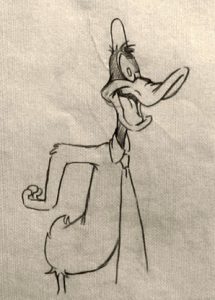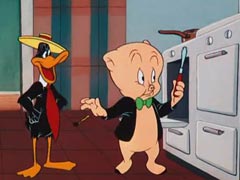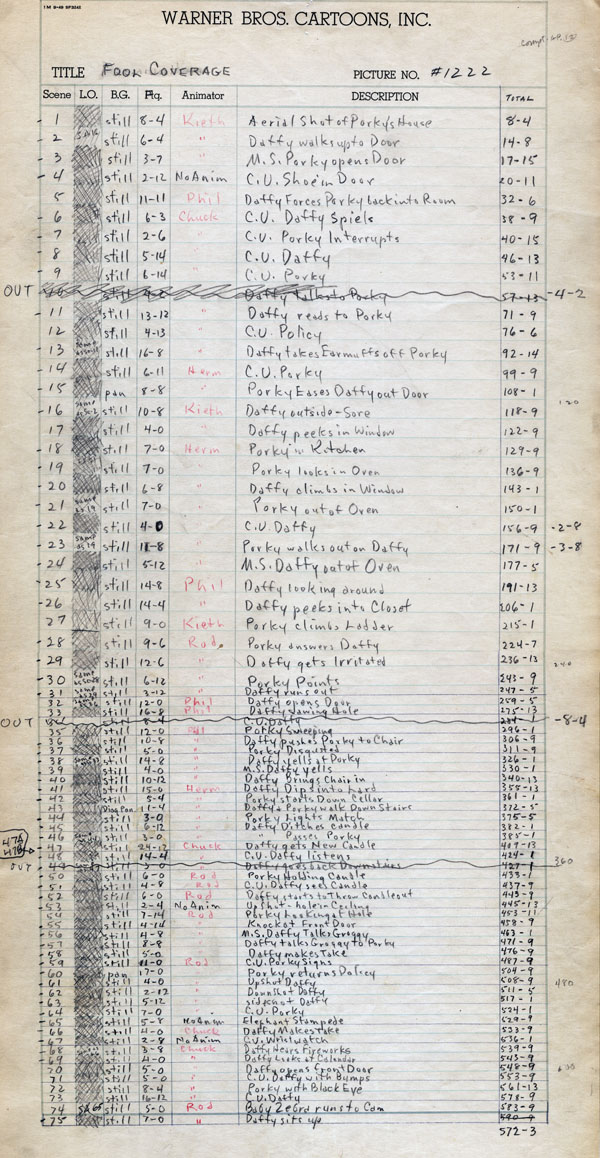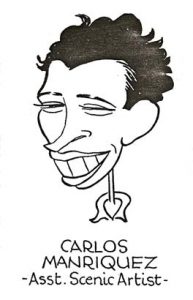
This week’s breakdown features Daffy Duck, Porky Pig, and a highly eccentric insurance policy…
Insurance policies, whether accidental or fatal, found themselves in various live-action comedy films and lent itself to animation, as well. For the latter medium are a few examples in Accidents Won’t Happen (1925), Mutt and Jeff devise a series of false calamities in order to collect their money; both Disney’s Flying Jalopy (1943) and Lantz’s Wet Blanket Policy (1948) have swindler buzzards with an intent to murder their client – Donald Duck and Woody Woodpecker, respectively – after a crooked arrangement is signed to collect their earnings after death.
 In Bob McKimson’s cartoon, salesman Daffy Duck creates business for himself in Porky Pig’s house, by devising his own mishaps. Daffy’s scheme goes further – the policy he wishes his valued customer to sign, with a guarantee of a million dollar sum for a black eye, contains inane provisions improbable to appear.
In Bob McKimson’s cartoon, salesman Daffy Duck creates business for himself in Porky Pig’s house, by devising his own mishaps. Daffy’s scheme goes further – the policy he wishes his valued customer to sign, with a guarantee of a million dollar sum for a black eye, contains inane provisions improbable to appear.
Mel Blanc recorded the dialogue track for Fool Coverage on January 13, 1951, and the film was released in theaters on December 1952. In scene 29, animated by Rod Scribner, Daffy attempts to have Porky trapped under a mound of clutter inside of his hall closet. Blanc’s line readings of Daffy’s increasing desperation, as he requests Porky to retrieve certain sporting items – which he doesn’t own – are nicely conveyed. Exhausted, he grimaces at the last possible option: a yo-yo. Later, near the end of the cartoon, also animated by Scribner, Porky shows a slight hint of avarice when he signs the policy and chuckles, until Daffy reminds Porky of the stipulations. (The cutting and simulated camera angles when he reiterates these provisions, with layouts by Bob Givens, sell the scene further.)
 McKimson’s animators are given small blocks of scenes, as well as their own extended sequences in the film. Charles McKimson animates the opening scenes of Daffy explaining the policy and reading the small print to Porky, putting earmuffs on him for the latter protocol. Herman Cohen handles the scenes of Daffy’s first scheme to prove Porkys home isn’t accident-free, as he shines a flashlight inside of his oven instead of a match. Cohen animates Daffy storming inside Porkys kitchen – with movement that’s strikingly similar to his animation of the Big Bad Wolf’s son in the opening of The Turn-Tale Wolf, released a few months earlier.
McKimson’s animators are given small blocks of scenes, as well as their own extended sequences in the film. Charles McKimson animates the opening scenes of Daffy explaining the policy and reading the small print to Porky, putting earmuffs on him for the latter protocol. Herman Cohen handles the scenes of Daffy’s first scheme to prove Porkys home isn’t accident-free, as he shines a flashlight inside of his oven instead of a match. Cohen animates Daffy storming inside Porkys kitchen – with movement that’s strikingly similar to his animation of the Big Bad Wolf’s son in the opening of The Turn-Tale Wolf, released a few months earlier.
Phil De Lara animates the rocking-chair sequence, where Daffy saws holes in the floor and covers them up with a rug. When Porky doesnt use the chair correctly, a frustrated Daffy demonstrates and falls into the trap, with a priceless deadpan expression. Scribner also animates Daffy holding Porky’s candle, which he replaces with a lit firecracker, painted white. There’s a great timing solution in the following scene, with the explosion occurring just after the key anticipation pose of Daffy about to toss out the phony candle. Keith Darling is credited in the draft for Fool Coverage, but not underneath the main titles, probably due to his small amount of footage, compared to the credited artists in the film.
Carlos Manriquez is credited for the backgrounds in this cartoon, one of only four credits for the studio in the early 50s (The other three titles were Jones’ Don’t Give Up the Sheep, Freleng’s Snow Business and McKimson’s Muscle Tussle, each released in 1953.)
Manriquez was born in San Dimas, Mexico in April 1908. His family came to the United States in 1922. He began his career in animation at the Disney studio in the ink-and-paint department, and later became the studios first full-time background painter by late 1929. (Before then, the animators were responsible for their own layouts and backgrounds.) When Emil Flohri, an older veteran of political cartoons and magazine illustrations, was hired in early 1930 as a background artist, Manriquez became his assistant. He left the studio in 1938, after which he helped incorporate Tel-A-Tale, intended to produce and distribute animated films, on February 1939. Very little is known about the company, including how long it existed. In the late 50s, Manriquez served as a supervisor at Val-Mar Animation (later Gamma Productions) in Mexico, where he overlooked the checking, ink-and-paint, and camera departments for Jay Ward’s Rocky and Bullwinkle. He passed away in May 1981 in Mexico City.
In the draft for this cartoon, Fool Coverage seems to have replaced other wordplay with insurance policies; the working title was Premium Ham. Scene 68 describes Daffy hearing fireworks which prompts him to check the calendar to clarify if the date is the Fourth of July, as the policy’s specifications transpire in Porkys house. No fireworks are heard in the film – likely a sound editing error though Daffy’s take makes it appear that he heard the music cue of Columbia, Gem of the Ocean before checking the calendar. Whether this small oversight was intentional, its a clever usage of an animated character aware of the non-diegetic sounds they aren’t meant to hear.
Enjoy!

(Thanks to Jerry Beck, Keith Scott, Hans Perk and Yowp for their help.)



 DEVON BAXTER is a film restoration artist, video editor, and animation researcher/writer currently residing in Pennsylvania. He also hosts a
DEVON BAXTER is a film restoration artist, video editor, and animation researcher/writer currently residing in Pennsylvania. He also hosts a 





















































































Just as Bob Clampett tended to give Bob McKimson the majority of the close-up scenes in his cartoons, Bob tends to assign the close-ups to Charles McKimson in his efforts. But not all of them — he does save the most ‘extreme’ close-up images of Daffy for Rod Scribner in this one, showing that even though he toned down Scribner’s extremes from the Clampett era, he still knew to take advantage of Rod’s strength in doing characters’ reactions.
(Like a lot of Bob’s efforts by this time, the cartoon comes across as more grounded in the sitcom/two-reel comedy format than the Jones or Freleng efforts of the time. But there are enough good gags here from Tedd Pierce and animation based on those gags to make the whole thing work. And the use of facial and body shadows in the TNT candle scene is a rare luxury for a 1950s Warner Bros. cartoon.)
Any possibility of looking at McKImson’s Bugs and Daffy cartoons Big Top Bunny and The Muscle Tussle please?
It would have been interesting if Fool Coverage had come out in 3D – with that realistic elephant stampede. When I first saw that elephant stampede (on television) It literally spooked the Heebie Jeebies out of me (and probably every single kid who saw this)!
Interesting that the elephant stampede is listed as having no animation. Perhaps because the elephant animation is reused from another film? I remember a Tweety and Sylvester cartoon where they’re hiding in a hotel and the final gag has a stampede of animals running down the lobby, including the elephant as he appears in this short.
It was Room and Bird (1951) where in the climax that the security guard announcing the eviction of all pets including Tweety, Sylvester and Hector out of the Spinster Arms Hotel where Granny lived… and to his horror a menagerie of animals lead by herd – of a pack of dogs followed by the stampeding elephant, which possibly every elderly lady snuck in the hotel – rampage through the lobby trampling the security guard.
This is one of those sleeper favorites of mine, and I’m glad that we actually have it on DVD. It was shown a lot with some gags excised, on local TV. Thanks for pointing out the seeming sound error in the cartoon regarding the possibility of Daffy hearing fireworks. I guess I thought that Daffy was just reacting to seeing that the calendar displayed the date as the 4th of July.
I don’t recall this short being edited when it was broadcast on WGN-9 in Chicago through 1990, nor was it edited when it was on THE BUGS BUNNY & TWEETY SHOW on ABC.
Excellent..and don ‘t forget the “Daff Duck & Porky Pig” in title card that survived to the notorious Blue Ribbons..only basic scenes, stretched, but kept suffienct:
I like McKimson’s cartoons, don’t get me wrong, but I really don’t like this character model for Daffy.
He looks like Joe Besser.
This and Daffy’s Inn Trouble were some of McKimson’s stronger cartoons IMO.